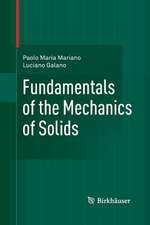Shape Optimization Problems: Springer Optimization and Its Applications, cartea 164
Autor Hideyuki Azegamien Limba Engleză Paperback – 2 oct 2021
This book provides theories on non-parametric shape optimization problems, systematically keeping in mind readers with an engineering background. Non-parametric shape optimization problems are defined as problems of finding the shapes of domains in which boundary value problems of partial differential equations are defined. In these problems, optimum shapes are obtained from an arbitrary form without any geometrical parameters previously assigned. In particular, problems in which the optimum shape is sought by making a hole in domain are called topology optimization problems. Moreover, a problem in which the optimum shape is obtained based on domain variation is referred to as a shape optimization problem of domain variation type, or a shape optimization problem in a limited sense. Software has been developed to solve these problems, and it is being used to seek practical optimum shapes. However, there are no books explaining such theories beginning with their foundations.
The structure of the book is shown in the Preface. The theorems are built up using mathematical results. Therefore, a mathematical style is introduced, consisting of definitions and theorems to summarize the key points. This method of expression is advanced as provable facts are clearly shown. If something to be investigated is contained in the framework of mathematics, setting up a theory using theorems prepared by great mathematicians is thought to be an extremely effective approach. However, mathematics attempts to heighten the level of abstraction in order to understand many things in a unified fashion. This characteristic may baffle readers with an engineering background. Hence in this book, an attempt has been made to provide explanations in engineering terms, with examples from mechanics, after accurately denoting the provable facts using definitions and theorems.
| Toate formatele și edițiile | Preț | Express |
|---|---|---|
| Paperback (1) | 798.81 lei 6-8 săpt. | |
| Springer Nature Singapore – 2 oct 2021 | 798.81 lei 6-8 săpt. | |
| Hardback (1) | 805.29 lei 6-8 săpt. | |
| Springer Nature Singapore – oct 2020 | 805.29 lei 6-8 săpt. |
Din seria Springer Optimization and Its Applications
- 15%
 Preț: 642.00 lei
Preț: 642.00 lei - 15%
 Preț: 664.61 lei
Preț: 664.61 lei - 18%
 Preț: 961.55 lei
Preț: 961.55 lei - 17%
 Preț: 360.79 lei
Preț: 360.79 lei - 13%
 Preț: 458.08 lei
Preț: 458.08 lei -
 Preț: 336.79 lei
Preț: 336.79 lei - 18%
 Preț: 787.91 lei
Preț: 787.91 lei - 17%
 Preț: 397.79 lei
Preț: 397.79 lei - 8%
 Preț: 337.37 lei
Preț: 337.37 lei - 18%
 Preț: 1133.30 lei
Preț: 1133.30 lei - 15%
 Preț: 646.43 lei
Preț: 646.43 lei - 15%
 Preț: 647.40 lei
Preț: 647.40 lei -
 Preț: 400.47 lei
Preț: 400.47 lei -
 Preț: 379.86 lei
Preț: 379.86 lei -
 Preț: 383.90 lei
Preț: 383.90 lei -
 Preț: 388.48 lei
Preț: 388.48 lei -
 Preț: 546.26 lei
Preț: 546.26 lei - 15%
 Preț: 647.40 lei
Preț: 647.40 lei -
 Preț: 390.25 lei
Preț: 390.25 lei - 15%
 Preț: 649.87 lei
Preț: 649.87 lei - 24%
 Preț: 611.55 lei
Preț: 611.55 lei - 18%
 Preț: 972.62 lei
Preț: 972.62 lei - 20%
 Preț: 585.91 lei
Preț: 585.91 lei - 15%
 Preț: 710.09 lei
Preț: 710.09 lei - 18%
 Preț: 742.61 lei
Preț: 742.61 lei - 15%
 Preț: 658.22 lei
Preț: 658.22 lei - 15%
 Preț: 659.02 lei
Preț: 659.02 lei - 18%
 Preț: 745.15 lei
Preț: 745.15 lei - 15%
 Preț: 705.34 lei
Preț: 705.34 lei
Preț: 798.81 lei
Preț vechi: 974.16 lei
-18% Nou
Puncte Express: 1198
Preț estimativ în valută:
152.86€ • 160.32$ • 127.25£
152.86€ • 160.32$ • 127.25£
Carte tipărită la comandă
Livrare economică 01-15 aprilie
Preluare comenzi: 021 569.72.76
Specificații
ISBN-13: 9789811576201
ISBN-10: 9811576203
Ilustrații: XXIII, 646 p. 202 illus., 3 illus. in color.
Dimensiuni: 155 x 235 mm
Greutate: 0.93 kg
Ediția:1st ed. 2020
Editura: Springer Nature Singapore
Colecția Springer
Seria Springer Optimization and Its Applications
Locul publicării:Singapore, Singapore
ISBN-10: 9811576203
Ilustrații: XXIII, 646 p. 202 illus., 3 illus. in color.
Dimensiuni: 155 x 235 mm
Greutate: 0.93 kg
Ediția:1st ed. 2020
Editura: Springer Nature Singapore
Colecția Springer
Seria Springer Optimization and Its Applications
Locul publicării:Singapore, Singapore
Cuprins
Preface.- Notation.- Chapter 1: Basics of Optimal Design.- Chapter 2: Basics of Optimization Theory.- Chapter 3: Basics of Mathematical Programming.- Chapter 4: Basics of Variational Principles and Functional Analysis.- Chapter 5: Boundary Value Problems of Partial Differential Equations.- Chapter 6: Fundamentals of Numerical Analysis.- Chapter 7: Abstract Optimum Design Problem.- Chapter 8: Topology Optimization Problem of Density Variation Type.- Chapter 9: Shape Optimization Problems of Domain Variation Type.- Answers to Practice Problems.- Afterword.- References.- Index.
Recenzii
“The book is written clearly. Key points of the presentation are summarized, and the theorems are formulated using well-known mathematical results. … The book is appropriate for use in a graduate course or for self-study. Each chapter ends with a diverse list of exercises. Again, the solutions to these exercises can be found at the end of the book. This book will be a valuable resource for engineering graduate students or experts on structural optimization problems and related areas.” (Andrzej M. Myśliński, Mathematical Reviews, March, 2022)
Textul de pe ultima copertă
This book provides theories on non-parametric shape optimization problems, systematically keeping in mind readers with an engineering background. Non-parametric shape optimization problems are defined as problems of finding the shapes of domains in which boundary value problems of partial differential equations are defined. In these problems, optimum shapes are obtained from an arbitrary form without any geometrical parameters previously assigned. In particular, problems in which the optimum shape is sought by making a hole in domain are called topology optimization problems. Moreover, a problem in which the optimum shape is obtained based on domain variation is referred to as a shape optimization problem of domain variation type, or a shape optimization problem in a limited sense. Software has been developed to solve these problems, and it is being used to seek practical optimum shapes. However, there are no books explaining such theories beginning with their foundations.
The structure of the book is shown in the Preface. The theorems are built up using mathematical results. Therefore, a mathematical style is introduced, consisting of definitions and theorems to summarize the key points. This method of expression is advanced as provable facts are clearly shown. If something to be investigated is contained in the framework of mathematics, setting up a theory using theorems prepared by great mathematicians is thought to be an extremely effective approach. However, mathematics attempts to heighten the level of abstraction in order to understand many things in a unified fashion. This characteristic may baffle readers with an engineering background. Hence in this book, an attempt has been made to provide explanations in engineering terms, with examples from mechanics, after accurately denoting the provable facts using definitions and theorems.
Caracteristici
Introduces most theories related to non-parametric shape optimization problems Summarizes basic theories in the first six chapters, with Chap. 4 especially valuable for engineers Devotes the three final chapters to shape and topology optimization problems after providing their abstract framework
























